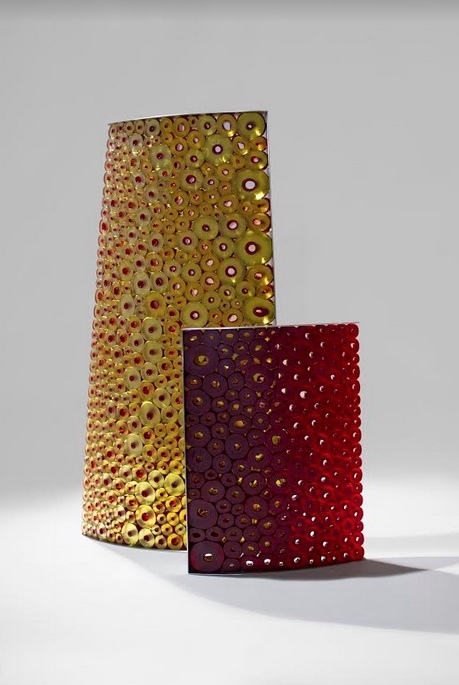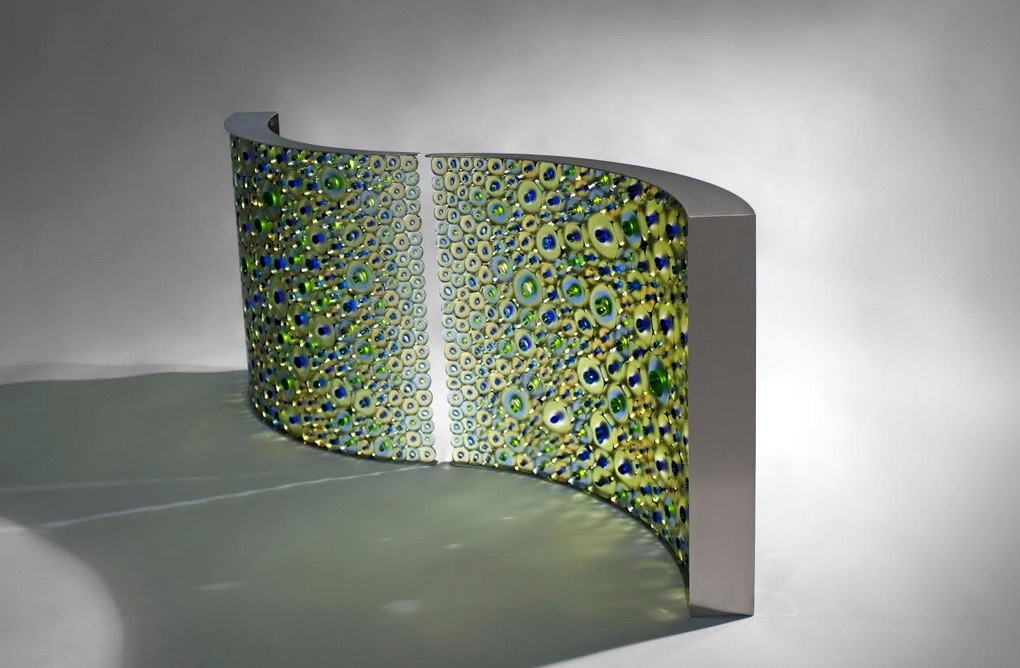Mesmerically patterned and radiant, the works of Australian artist Matthew Curtis are something uncanny in how they read as both organic and artificial. Inspired by what Curtis describes in his artist statement as the "exquisite architecture of cellular growth and how these biologically derived structures are reflected in our built environment," the interplay between the man-made solidity of the materials and the light and delicacy of glass filaments. With an opening on June 8th and running through July 15th, they will be on view at LewAllen Galleries in Santa Fe, New Mexico, in an exhibition entitled "Matthew Curtis: Intersect."

Blown and fused glass, stainless steel.
H 23 1/2 , W 17 3/4 , D 8 in. courtesy: beth hirsch.
Born in Luton, England in 1964, Curtis moved to Australia in 1981, where he embarked upon his career in glass-making in 1991 as an assistant to Robert Wynne at Denizen Glass. His work has since been exhibited internationally and included in numerous private and public collections. Working from his own studio, Curtis develops his own colors and tints within the hot shop and often combines unlike materials. This aim to "broaden the possibilities of the medium," as expressed by LewAllen Gallery owner Robert Gardner, has distinguished him as "one of the most innovative, up-and-coming voices in contemporary glass sculpture."
His artistic practice is often preoccupied with the overlap between the natural and constructed worlds, and it comes through powerfully in this latest exhibition. In "Intersect," the pieces are amalgamations of various smaller, blown and cast elements and details that have been fused together into larger forms, and then carved and ground. The result is reminiscent of a cross section in the lab, full of natural irregularities and intersecting forms, alive with a sense of rhythm. As Curtis has commented in his artist statement: "The material speaks of the language of modern architecture, a strong and hard material. While the simple lines of the steel sympathetically follow the more delicate planes and cross sections of glass. Although both materials can appear hard and at times unforgiving, they also provide exquisite detail and transparent delicacy."
Beyond the spectacular qualities of the work itself, it is also interesting that his work is being featured at LewAllen among a range of other mediums, rather than in a space solely dedicated to glass. When asked about their approach to exhibiting glass art, LewAllen gallery owner Ken Marvel stated: "We seek work in glass that utilizes the medium to converge form, color and light in order to produce art that engages the eye in significant, intelligent and pleasurable ways. Though we intend to keep our roster of glass artists relatively small, we will continue to be on the lookout for artists who make innovative and engaging work that complements our program."
Marvel further noted: "Many of our artists working in glass have mentioned how they were interested, at the outset, in showing their work next to paintings and other sculpture. They felt that it elevated their work when shown in the context of a contemporary fine art gallery." And on the other side of the picture, they have noticed a growing awareness and appreciation among clients of the possibilities of glass art as a legitimate art form, as well as of glass-making techniques and leading glass artists - of which Matthew Curtis is certainly one.




